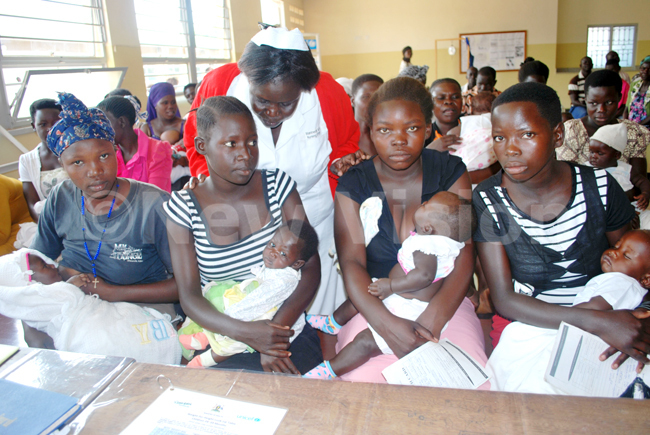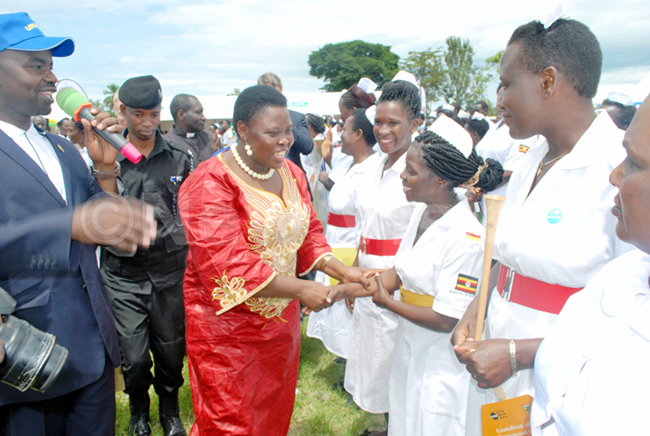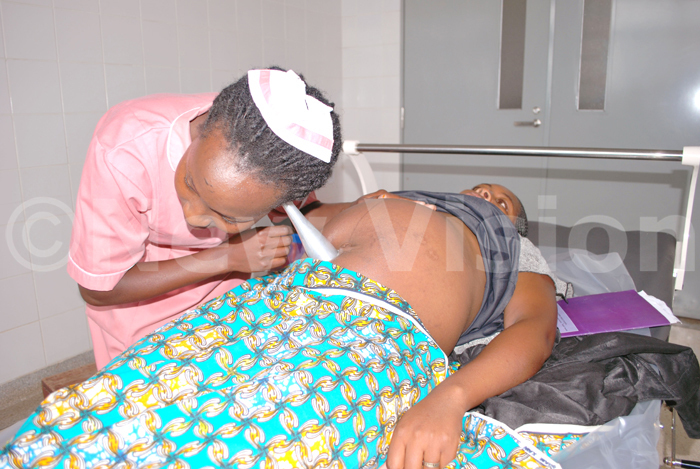Priority health issues for 2018
The health ministry through the malaria control programme will continue to carry out research because the parasites for malaria develop resistance.
PIC: The Ministry of Health will prioritise early screening for non-communicable diseases
HEALTH | PRIORITIES FOR 2018
UGANDA - Uganda is currently grappling with a huge burden of both infectious and non-communicable diseases. Preliminary results from the Uganda Population Based HIV Impact Assessment (UPHIA) 2016/17 show that the national HIV prevalence stands at 6.2%. The prevalence rate among women has remained high at 7.6% compared to 4.7% among men.
Additionally, the malaria indicator survey (2014) shows that malaria is still the leading cause of death among Ugandans, accounting for over 19 % of lives.
Such poor health indicators mean that the Government and individuals spend a lot of money on treating diseases. Therefore, there is need to give health promotion and disease prevention priority. The 2016 data from Ministry of Health shows that over 75% of the disease burden in Uganda is preventable.
It is upon this background that the Ministry of Health chose to prioritise health promotion, prevention and early intervention in the 2018.
Malaria burden
The national malaria prevalence reduced from 42% (MIS 2009) to 19%, according to the malaria indicator survey (MIS) 2014.
Dr. Myers Lugemwa, who works with the Malaria Control Programme at the health ministry, says although there is no one single magic bullet in reducing the malaria prevalence. However, this year, the health ministry will continue to treat all malaria cases as they present at all health facilities. Pregnant women will be given preventive drugs, Fancidar, to protect them against complications of malaria in pregnancy.
Together with partners, the ministry will continue to do indoor residual spraying in 20 epidemic districts in the northern and eastern regions, distribute treated mosquito nets, sensitise people to sleep under treated mosquito nets and to clear places where mosquitos breed for example, bushes and stagnant water around homes.
The health ministry through the malaria control programme will continue to carry out research because the parasites for malaria develop resistance.

The health ministry will ensure that mothers deliver healthy babies by giving them prophylaxis (Fancider) against malaria during pregnancy
Non- communicable diseases on an increase
A study conducted in 2014 on the prevalence of non-communicable diseases by the health ministry and World Health Organisation (WHO) indicated that about 24.3% of adults have hypertension (high blood pressure) 1.3% have diabetes and 5% of the population is obese.
Dr Gerald Mutungi, the programme manager for non-communicable diseases at the health ministry, attributes the increase to poor lifestyle habits.
Poor lifestyle habits, for example, unhealthy diets comprised of sugary, fatty and salty foods.
Other unhealthy habits include: tobacco and alcohol abuse and physical inactivity. These put one at the risk of excessive weight gain referred to as obesity, which is a major risk factor for non-communicable diseases.
In a bid to fight the diseases, the health ministry is focusing on creating awareness about the risk factors. For example, it came up with the Tobacco Law and currently, the ministry is drafting the Alcohol control bill.
This is intended to control the packaging of alcohol in small quantities, for example sachets; limit the drinking hours from 5:00pm to midnight, selling of alcohol only in licensed premises, for example, bars and supermarkets. This is intended to limit access of alcohol by school-going children.
Screening and early diagnosis of non-communicable diseases will be done through establishment of wellness clinics in our health facilities where people can go and screen even when they are not sick, Mutungi explains.
Aside, they will improve diagnostic and treatment capacities to bring management of non-communicable diseases closer to people; at health center III and IVs, Mutungi said.
Specialised medical services
Every day, patients are flown abroad to seek specialised medical services. In order to offer super specialised health services and consequently reduce referrals abroad, the health sector developed a proposal with major focus on improving Uganda Cancer Institute, Uganda Heart Institute and Mulago Hospital.
The principal hospital administrator Mulago, David Nuwamanya, confirmed that the construction of Mulago specialised maternal and neonatal health care unit, as well as renovation for New Mulago is almost complete and they will both open in March 2018.
Some services will be paid for by the Government while others will be paid for by the consumer.
However, details of what services will be paid for and at what cost will be determined after the Cabinet and Parliament have approved the Mulago National Specialised Hospital 2017 Bill. The drafting of the bill is being finalised with the solicitor general.

Staffing of midwives and nurses will be an area of emphasis in 2018
Universal health coverage
The health ministry through its health financing strategy is going to address the financing component of universal health coverage, said Ali Walimbwa, a senior health planner, who also doubles as the deputy co-ordinator of the national health insurance scheme.
According to Walimbwa, the first strategy in reducing out-pocket expenditure on health is promotion of pre-payment schemes for example, the national insurance scheme (NHIS), which the ministry is currently pushing for.
Through the scheme, people will contribute what they can afford. Those who cannot will be subsidised by the Government and those who cannot pay completely will be exempted from paying.
The ministry expects the NHIS bill to be tabled to Parliament by June (2018). Once the bill is passed, the scheme will start operating.
Walimbwa is optimistic that the NHIS will reduce out of pocket expenditure on health and attract private sector providers
Patients will present their medical cards at any of the accredited health facilities to receive treatment.
Improving staffing levels
The health workforce is the most important component of any health system, says Dr Sarah Byakika, the Assistant commissioner in charge of the planning at the health ministry.
The Human Resource for Health Audit report 2016/17 indicates that the overall staffing levels have progressively increased from 71% (2015/16) to 73% (2017).
However, Byakika says this still remains a big challenge as the staffing levels are still below the approved staffing norms as per the health ministry.
The number of health workers is still inadequate, specifically for the critical human resource for health, for example, nurses and midwives, anesthetic officers, psychiatrists, which greatly affects the staffing levels, she says.
The status of human resource for Uganda report shows that the health worker population ratio has improve from 1.29 (2014) to 1.79/1000 (2017) population. However, this is still below the World Health Organisation recommended ratio of 2.28 per 1000 population.
Data from the Uganda Nurses and Midwives Council (UNWC) Uganda has 15,330 registered and enrolled midwives. Of these, only 9,587 midwives are licensed to practice although not all are employed in public health facilities. Consequently, this leaves the midwifery positions not filled according to the staffing norms of Ministry of Health.
Yet the World Health Organisation (WHO) guidelines stipulate that one midwife should conduct about 175 deliveries a year, those in Uganda conduct between 350 to 500 deliveries in a year due to work overload.
However, Byakika says the health ministry will revise the staffing norms for regional referral hospitals and local governments will help to address the current need.
They also plan to reduce absenteeism by use of automated biometric machines. This will consequently improve performance of health workers, Byakika affirms
The health ministry is going to introduce performance contracts with clearly spelt out work targets for all health workers. For easy identification, the ministry will continue to provide uniforms to health workers.

Although the midwives in Uganda have a big workload, the health ministry is planning to increase their staffing in public health facilities
Bill on indigenous and complementary medicine
For long, people have used indigenous and complementary medicine to treat various ailments. However, regulatory bodies, for example, Kampala Capital City Authority and National Drug Authority find it difficult to regulate the traditional health practitioners because there is no law.
To address such gaps, a Bill on indigenous and complementary medicine was drafted in 2015.
The Bill's aim is to create a council to regulate the traditional health practitioners.
According to Dr Grace Nambatya Kyeyune, the director of research natural chemotherapeutic laboratories at the health ministry, the Bill has been discussed twice in Parliament.
Nambatya is optimistic that come 2018, the Bill will be finally discussed and enacted into a law.
Byakika says after the Bill is passed, a joint monitoring team for all regulators, including the Uganda Communications Commission (UCC), Police and Ministry of Health will be established to enforce regulations.